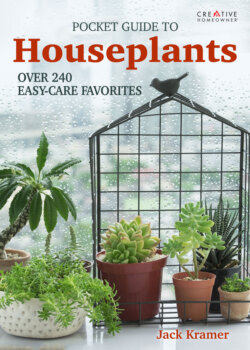Читать книгу Stitching Pathways - Jack Kramer - Страница 18
На сайте Литреса книга снята с продажи.
Soil
ОглавлениеUnlike most garden plants, houseplants are in containers and cannot send their roots far down through the soil to seek water and nutrients. So it is up to you to supply the right balance of nutrients and moisture by providing the plants with good-quality potting soil. Standard all-purpose houseplant soil works fine for most plants.
4 Rules for Potting
• Look for soil that is a rich black color.
• Here’s a recipe for all-purpose potting soil: mix 5 qt. (4.75 L) soil with 2 c (0.5 L) compost.
• If you purchase a plant sold in a mix, plan to repot the plant into good soil eventually—in a few weeks, for instance.
• Be sure that any container into which you are potting has drainage holes—soggy soil may lead to root rot. Don’t forget the saucer (see here)!
How to Repot a Houseplant
1. Disinfect any containers that were previously used by soaking them in a solution that is one part chlorine bleach and nine parts water. Rinse with clear water. Put a piece of mesh screen over the drainage hole so the soil doesn’t wash out. Cover the screen with a layer of pot shards.
2. Before potting, cover the bottom of a clean container with pot shards and horticultural charcoal. The shards improve drainage, and the charcoal helps drainage and sweetens the soil, keeping it fresh.
3. After removing the plant by tapping the bottom of the pot on a hard surface, grasp the plant by its crown, and gently tease it out of the pot. If the plant won’t budge, slide a butter knife between the rootball and the pot, and slice around the inside of the pot.
4. Use your fingers to crumble away the old soil, and remove dead, brown roots. If the roots have taken on the shape of the container, use a fork to pull them straight or a knife to slice through them. Make three or four vertical cuts from the crown to the base.
5. Holding the plant in one hand and a trowel in the other, scoop fresh soil into the pot. Position the plant on top of the soil. Then adjust the soil level until the crown of the plant is just above the edge of the pot.
6. Center the plant in the pot. Add soil to fill the space between the roots and the pot and to cover the roots. Press soil firmly with your thumbs to eliminate air pockets. Keep the soil level 1/2 in. (13 mm) below the pot rim to prevent overflow when watering.
7. Water the plant thoroughly in its new pot. After a few minutes, water it again. Wait ten minutes, then discard any water sitting in the saucer. You may want to cover the plant with a plastic bag to retain moisture and lessen the chances of transplant shock.
